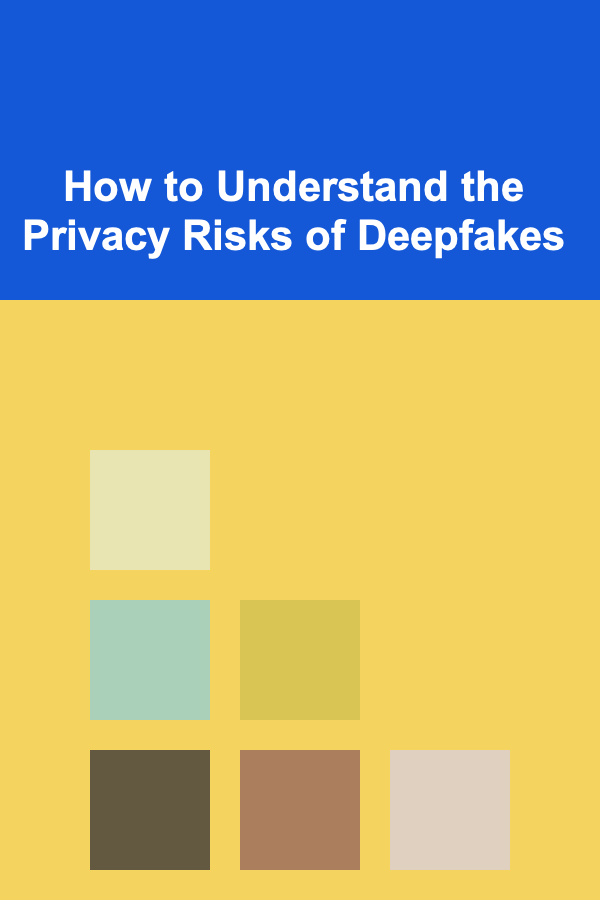
How to Understand the Privacy Risks of Deepfakes
ebook include PDF & Audio bundle (Micro Guide)
$12.99$5.99
Limited Time Offer! Order within the next:

In recent years, deepfakes have become a growing concern in the digital age. These artificial media, created through advanced machine learning techniques, allow for the creation of hyper-realistic videos, audios, and images that can manipulate reality in astonishing ways. While deepfakes have the potential to revolutionize industries such as entertainment and education, they also present significant privacy risks. This article delves into the complexities of deepfakes, examining the privacy risks they pose, their implications on personal security, and how we can mitigate these threats.
What Are Deepfakes?
Deepfakes refer to the use of artificial intelligence (AI) to manipulate or generate visual and audio content that appears authentic but is entirely fabricated. The term "deepfake" is a combination of "deep learning," a subset of AI, and "fake," meaning the content is deceptive. Deepfake technology uses generative adversarial networks (GANs) to train models that can create realistic representations of faces, voices, and other features.
Although the technology behind deepfakes is sophisticated, it can be used by anyone with access to AI tools, making the creation of these synthetic media more accessible. While the majority of deepfakes are used for entertainment purposes, such as in movies or videos, they can also be misused for malicious reasons, creating significant privacy risks.
The Privacy Risks of Deepfakes
Deepfakes present a unique set of privacy risks that can be classified into several categories:
1. Identity Theft and Impersonation
One of the most concerning privacy risks associated with deepfakes is the ability to impersonate individuals. Deepfake technology allows perpetrators to superimpose someone's face or voice onto another person's body or actions, creating the illusion that the individual is doing or saying something they never actually did.
This has severe implications for personal identity and security. For example, a deepfake video could show a person engaged in criminal activities, saying or doing things that could harm their reputation. In some cases, deepfakes can be used to impersonate individuals in sensitive scenarios, such as in financial transactions or legal matters, leading to severe consequences such as fraud, blackmail, or defamation.
2. Invasion of Privacy
Deepfakes can be used to violate an individual's privacy by creating fabricated content that features them in compromising situations. For instance, deepfake technology has been used to create fake videos of people in explicit or embarrassing contexts, leading to emotional distress and reputational harm.
This type of deepfake abuse is particularly concerning when it comes to public figures, celebrities, or even private individuals who have become targets of harassment. The ability to fabricate personal and intimate moments without consent represents a significant threat to privacy and personal well-being.
3. Manipulation of Public Opinion
The use of deepfakes to manipulate political discourse and public opinion has become a major concern. Deepfakes can be used to create videos that mislead the public into believing that a political figure has made controversial or damaging statements. These fake videos can spread misinformation, incite violence, or sway elections by distorting the truth.
In the political realm, deepfakes can also be used to create fabricated interviews or speeches, which can influence voters' perceptions of candidates or governments. The impact of deepfakes in politics highlights the need for greater scrutiny and accountability in the digital media landscape.
4. Cybersecurity Threats
Another serious privacy risk posed by deepfakes is their potential use in cybersecurity attacks. With deepfakes, attackers can create convincing impersonations of colleagues, bosses, or even clients to deceive organizations into revealing sensitive information or approving fraudulent transactions. For example, a deepfake could be used to mimic a CEO's voice in a phone call or email, convincing employees to wire money or divulge confidential data.
These attacks are especially dangerous because they can bypass traditional security measures such as passwords or two-factor authentication. A deepfake could effectively manipulate an individual into making decisions that compromise an organization's security, leading to data breaches, financial losses, or reputational damage.
5. Legal and Ethical Issues
The rise of deepfake technology also presents legal and ethical challenges. Many legal systems struggle to address the implications of deepfakes, particularly when it comes to issues like defamation, harassment, and fraud. For instance, if someone is victimized by a deepfake and suffers reputational harm, it can be difficult to seek legal recourse, as the technology allows for the creation of media that can be easily disguised as authentic.
Ethically, deepfakes raise questions about consent and the rights of individuals whose likenesses are used in fabricated content. For example, should someone have the right to control how their face or voice is used in deepfake media? The ethical implications extend beyond individual cases, as deepfakes challenge our understanding of ownership and responsibility in the digital realm.
The Impact of Deepfakes on Society
Beyond individual privacy risks, deepfakes have the potential to undermine the trust that forms the foundation of our social interactions. The ability to create convincing fake content challenges the authenticity of the media we consume, making it difficult to distinguish between truth and deception.
1. Erosion of Trust in Media
As deepfake technology becomes more sophisticated, it becomes harder for the public to trust the authenticity of video and audio content. News organizations and media outlets that rely on video evidence may find their credibility questioned, as deepfakes can be used to alter key pieces of information. For example, a deepfake video of a news anchor could spread misinformation that is indistinguishable from real footage, eroding public trust in journalism.
This distrust can extend beyond the media to affect personal interactions. In a world where deepfakes are commonplace, individuals may become skeptical of online content, unsure of whether the people they are engaging with are real or fake.
2. Undermining Democracy
In democratic societies, the spread of misinformation can have far-reaching consequences. Deepfakes can be used to create false narratives that influence public opinion, political campaigns, and electoral outcomes. The manipulation of deepfake media for political purposes can result in the distortion of democratic processes, as voters may be swayed by fake content that misrepresents candidates or issues.
The potential for deepfakes to undermine democracy is particularly concerning when combined with social media platforms, where fake content can spread rapidly and reach a large audience. This creates a situation where the truth becomes difficult to discern, and public discourse becomes distorted by artificial manipulation.
3. Cultural and Social Harm
The spread of deepfakes can also contribute to broader cultural and social harm. For example, deepfakes have been used to create fake pornography featuring individuals who have not consented to such content. This type of exploitation not only violates the privacy of the individuals involved but also perpetuates harmful stereotypes and encourages harassment.
Deepfake abuse can contribute to the normalization of digital exploitation, where individuals' likenesses are commodified without their consent. This type of cultural harm reinforces negative social behaviors and erodes respect for personal boundaries and autonomy.
How to Mitigate the Privacy Risks of Deepfakes
While deepfakes present serious privacy risks, there are several strategies that individuals, organizations, and governments can use to mitigate these threats.
1. Awareness and Education
One of the most effective ways to combat the privacy risks of deepfakes is through education and awareness. Individuals need to be aware of the existence of deepfakes and how to spot them. Media literacy programs can help people identify warning signs of manipulated content, such as unnatural movements, inconsistencies in lighting or shadows, or audio mismatches.
For organizations, educating employees about the risks of deepfakes and implementing training programs to recognize and respond to potential threats is essential. This can include recognizing phishing attempts that may be disguised using deepfake technology.
2. Technological Solutions
Several technological solutions have been developed to detect deepfakes. These include AI algorithms that can analyze videos and audio files to identify inconsistencies or anomalies that suggest manipulation. While these tools are still in development, they show promise in helping to distinguish between real and fake content.
For example, some companies are developing systems that can analyze facial expressions, eye movement, and other subtle features to determine whether a video has been altered. Governments and organizations can use these technologies to monitor and verify the authenticity of media content.
3. Regulation and Legislation
Governments play a critical role in addressing the privacy risks of deepfakes. By enacting legislation that makes the creation and distribution of malicious deepfakes illegal, lawmakers can create a legal framework that holds perpetrators accountable. This may include laws against defamation, harassment, and identity theft related to deepfake abuse.
In addition, policies can be introduced that require platforms such as social media networks and video-sharing websites to implement safeguards against deepfake content. For example, platforms can use AI tools to detect and remove deepfake videos or flag potentially harmful content before it is widely shared.
4. Stronger Digital Identity Protections
As deepfakes become more prevalent, strengthening digital identity protections will be essential. Individuals can take steps to secure their online presence by using technologies such as biometric authentication and digital signatures to verify their identity.
Organizations can implement more robust identity verification systems, such as voiceprint analysis or facial recognition, to prevent impersonation through deepfake technology. This will be particularly important in industries that rely on digital transactions or remote interactions.
Conclusion
Deepfakes are a powerful and potentially dangerous tool that raises significant privacy and security concerns. As the technology continues to evolve, it is crucial to understand the risks associated with deepfakes and take proactive steps to protect ourselves and our digital identities. Through awareness, education, technological solutions, and legal safeguards, we can mitigate the impact of deepfakes and ensure that the digital world remains a safe and trustworthy space for everyone.

How to Become a Real Estate Agent with No Prior Experience
Read More
How to Build an Emergency Fund Within Your Home Budget
Read More
How to Set Up a Home Safe to Protect Valuables
Read More
How to Stage a Home with Minimal Furniture
Read More
Solving Complex Cost Accounting Problems: Insights from Leading Experts
Read More
Optimizing Your Nutrition for Radiant Skin Health: A Deep Dive
Read MoreOther Products

How to Become a Real Estate Agent with No Prior Experience
Read More
How to Build an Emergency Fund Within Your Home Budget
Read More
How to Set Up a Home Safe to Protect Valuables
Read More
How to Stage a Home with Minimal Furniture
Read More
Solving Complex Cost Accounting Problems: Insights from Leading Experts
Read More